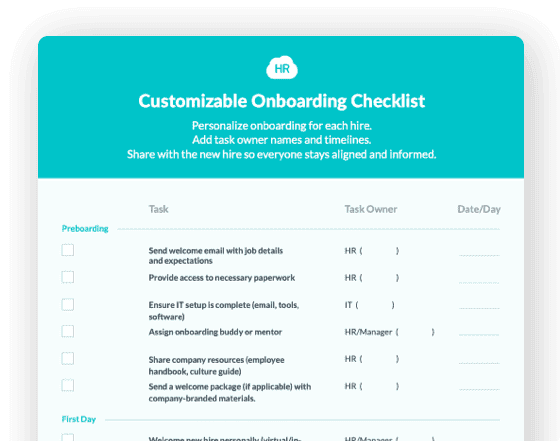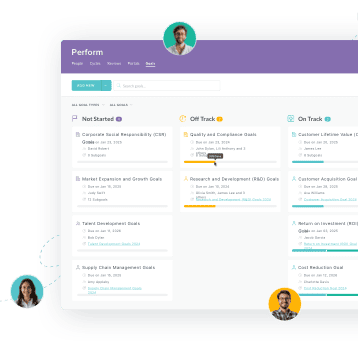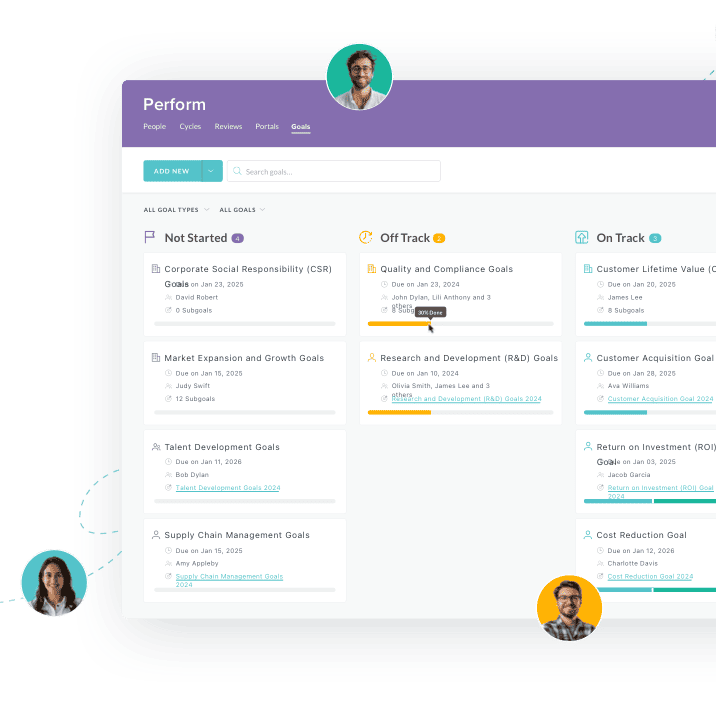Job Classification
- Key Points: What You Need to Know About Job Classification
- Comparison of Common Job Classification Methods
- Best Practices: Building an Effective Classification System
- Pitfalls to Avoid When Implementing Job Classification
- Industry Applications: How Different Sectors Use Job Classification
- Implementation Plan: Steps to Build Your Classification System
- Future Outlook and Trends in Job Classification

 Cut onboarding time
by 60%—here's the
Ultimate Checklist
that helped do it.
Cut onboarding time
by 60%—here's the
Ultimate Checklist
that helped do it.

Job classification is the process of evaluating and grouping positions within your organization based on their duties, responsibilities, and required qualifications. This systematic approach creates a structured framework that helps you determine compensation levels, establish clear career paths, and maintain internal equity across your workforce. When done right, job classification becomes the foundation for fair pay practices and transparent organizational structures that employees can understand and trust.
Think of job classification as the blueprint for your company's talent architecture. It answers critical questions like: What makes one role more senior than another? How should we pay fairly across departments? What skills and responsibilities justify a promotion? Without this structure, you risk creating confusion about roles, inconsistent compensation, and compliance headaches that can cost your organization dearly.
The importance of job classification extends far beyond simple organization charts. It directly impacts your ability to attract top talent by offering competitive salaries aligned with market rates. It influences employee satisfaction by providing clear growth paths and equitable treatment. According to SHRM policy on employee classification, proper classification helps organizations clarify employment status and benefits eligibility, which is fundamental for maintaining legal compliance and employee trust.
Understanding the Core Elements of Job Classification
Job classification involves several moving parts that work together to create a cohesive system. First comes job analysis, where you gather detailed information about what each position actually does on a daily basis. This means interviewing employees, observing work patterns, and documenting tasks and responsibilities. Next, you create standardized job descriptions that outline duties, required skills, and reporting relationships. Finally, you assign each position to a specific grade or level within your organizational hierarchy.
The classification process also determines whether positions are exempt or nonexempt under the Fair Labor Standards Act (FLSA). This designation affects overtime eligibility and has significant implications for both payroll costs and HR compliance. Getting this wrong can lead to costly legal disputes and back pay obligations that damage your bottom line and reputation.
Key Points: What You Need to Know About Job Classification
Before implementing or refining your job classification system, understand these fundamental principles:
-
Job classification evaluates the position itself, not the person currently holding it. Two people in the same role should have identical classifications regardless of their individual performance levels or tenure.
-
Classification systems create pay grades that link similar positions together. These grades establish minimum and maximum salary ranges that guide compensation decisions across your organization.
-
Effective classification requires regular updates as roles evolve. What made sense three years ago may no longer reflect current responsibilities or market conditions.
-
The process should balance internal equity with external competitiveness. Your classifications must feel fair to employees while remaining aligned with what competitors pay for similar work.
-
Clear documentation protects your organization. Written job descriptions and classification criteria defend against discrimination claims and support consistent decision making across departments.
-
Classification systems reduce subjective bias in compensation decisions by establishing objective criteria for evaluating positions.
Comparison of Common Job Classification Methods
|
Method |
How It Works |
Best For |
Limitations |
|
Point Factor |
Assigns numerical points based on skills, problem solving, and accountability |
Large organizations needing objectivity |
Time consuming to implement and maintain |
|
Job Ranking |
Orders positions from highest to lowest value |
Small companies with simple structures |
Becomes unwieldy as organization grows |
|
Classification |
Groups jobs into predefined categories or grades |
Government agencies and structured environments |
May not fit specialized or unique roles |
|
Hay System |
Evaluates know-how, problem solving, and accountability using standardized scales |
Organizations wanting comprehensive framework |
Requires expertise to implement properly |
Best Practices: Building an Effective Classification System
Creating a job classification system that actually works requires thoughtful planning and consistent execution. These best practices will help you avoid common pitfalls and build something sustainable.
Start with thorough job analysis. Take the time to really understand what people do every day. Talk to employees at all levels. Shadow workers in different departments. Review existing documentation and identify gaps. This groundwork prevents costly reclassification projects down the road when you discover your initial assessments missed critical responsibilities.
Involve stakeholders throughout the process. Your HR team should not work in isolation. Bring department managers into the conversation early. Seek input from employees who understand their roles better than anyone. When people help shape the system, they are more likely to trust and support it. This collaborative approach also surfaces insights that desk bound HR professionals might miss.
Use market data to validate your decisions. Your compensation structure should reflect what competitors pay for similar work. Conduct regular salary surveys. Benchmark against companies in your industry and geographic area. This external perspective keeps you competitive in talent markets while ensuring internal classifications align with real world value.
Document everything clearly. Written classification criteria, job descriptions, and decision rationales create transparency and consistency. They also provide legal protection when employees question their classifications or compensation levels. Store this documentation in your HRIS system where it remains accessible and organized.
Schedule regular reviews of your classification system. Set a cadence for auditing roles, whether annually or when major organizational changes occur. Jobs evolve as technology advances and business needs shift. Your classification system must keep pace or risk becoming obsolete and disconnected from reality.
Train managers on how classification decisions get made. Leaders who understand the system make better hiring and promotion choices. They can explain classification rationale to their teams with confidence. This knowledge prevents misunderstandings and builds trust across your organization.


Pitfalls to Avoid When Implementing Job Classification
Even well intentioned classification efforts can fail if you stumble into common traps. Understanding these mistakes helps you navigate around them.
Organizations often classify based on the person rather than the position. When your star performer exceeds expectations, you might feel tempted to reclassify their role to justify higher pay. Resist this urge. If the job duties have not genuinely expanded in scope or complexity, the classification should not change. Instead, use performance based compensation tools like bonuses to reward exceptional work.
Many companies fail to update classifications as roles naturally evolve. What started as a coordinator position five years ago might now involve supervisory duties and strategic planning. When you ignore these changes, you create internal inequity and risk losing talented employees who feel undervalued. According to research on job classification, outdated classifications are one of the most common complaints employees have about compensation systems.
Inconsistent application across departments creates perceptions of favoritism. If Marketing classifies similar roles differently than Operations, employees notice and trust erodes. Establish clear governance processes that ensure uniform standards apply throughout your organization regardless of department politics or budgets.
Overcomplicating the system makes it impossible to explain and maintain. While comprehensive frameworks have appeal, they can become so detailed that nobody understands them. Simpler systems that people actually use beat perfect systems that gather dust. Find the right balance between rigor and practicality for your organizational culture and size.
Ignoring compliance requirements creates legal exposure. Worker classification carries significant legal implications under wage and hour laws, benefits regulations, and tax codes. Mistakes in determining exempt versus nonexempt status can trigger Department of Labor investigations and costly remediation efforts.
Industry Applications: How Different Sectors Use Job Classification
Job classification looks different depending on industry context and organizational needs. These real world examples illustrate how various sectors adapt classification principles.
In healthcare settings, classification systems must accommodate complex credential requirements and multiple employee categories. Hospitals might have 15 different nursing classifications based on education level, specialty area, and years of experience. They need systems flexible enough to handle travel nurses, per diem staff, and full time employees while maintaining compliance with state licensing boards and union contracts. The classification framework must also integrate with credentialing databases and scheduling systems that match qualified staff to patient care needs.
Technology companies often use broadband classification structures that reduce the number of distinct grades. Instead of 20 narrow pay bands, they might have five broader categories that allow significant salary variation within each level. This approach supports rapid career growth for high performers without constant title changes. It also accommodates specialized technical roles that do not fit traditional hierarchies, like distinguished engineers who make significant contributions without managing people.
Manufacturing organizations frequently employ detailed classification systems that account for physical demands, hazardous conditions, and skill certifications. Machine operators might have six classification levels based on equipment complexity and maintenance responsibilities. Safety considerations factor heavily into these classifications, with higher grades assigned to positions requiring advanced training or exposure to greater risks.
Implementation Plan: Steps to Build Your Classification System
Ready to create or overhaul your job classification system? Follow this sequential approach to ensure thorough execution.
Start by assembling your project team. Include HR professionals who understand compensation, managers who know operational realities, and employees who can provide ground level perspectives. Assign clear roles and establish decision making authority upfront to prevent delays and confusion later.
Next, conduct comprehensive job analysis across your organization. Use questionnaires, interviews, and direct observation to gather information about duties, responsibilities, and requirements for each position. Document skills needed, decision making authority, supervision provided or received, and working conditions. This phase takes time but provides the data foundation for everything that follows.
Develop draft job descriptions based on your analysis findings. Write clear, concise descriptions that capture essential functions without getting lost in minutiae. Focus on what makes each role distinct and valuable to the organization. Share drafts with current job holders and their managers for feedback and refinement.
Select your classification methodology. Will you use point factor, job ranking, classification, or a hybrid approach? Consider your organizational size, complexity, and culture when making this choice. Research different methods to understand their strengths and limitations before committing.
Assign classifications to each position using your chosen methodology. Apply criteria consistently across departments. Document the rationale behind decisions for future reference. Use market data to validate that your classifications align with competitive compensation levels.
Implement your system with HRIS technology that centralizes job data, tracks classifications, and integrates with payroll systems. Technology reduces administrative burden and ensures consistency as your organization grows. It also creates audit trails that demonstrate compliance with employment regulations.
Communicate the new system transparently to your entire workforce. Explain how classifications were determined, what they mean for compensation and career paths, and how employees can seek reclassification when roles genuinely evolve. Answer questions openly and address concerns promptly to build trust in the new structure.
Future Outlook and Trends in Job Classification
Job classification continues evolving as work itself transforms. Several emerging trends will shape how organizations approach this critical HR function in coming years.
Artificial intelligence and machine learning are beginning to support classification processes. These technologies can analyze job descriptions at scale, identify patterns across similar roles, and suggest appropriate classifications based on historical data. While human judgment remains essential, AI tools will make classification faster and more consistent by flagging anomalies and surfacing market insights that inform decisions.
The rise of remote and hybrid work is forcing reclassification conversations. When location no longer constrains talent pools, should organizations pay based on employee location or job market rates? Should remote workers in lower cost areas receive the same compensation as office based colleagues? These questions challenge traditional geographic pay differentials and push organizations toward skills based classification that emphasizes capabilities over physical presence.
Skills based approaches are gaining momentum as alternatives to traditional job based classification. Instead of classifying specific positions, organizations identify core competencies needed across roles and compensate employees based on their skill portfolios. This model supports internal mobility, allows faster adaptation to changing business needs, and recognizes that modern careers rarely follow linear paths up fixed ladders.
Transparency expectations are rising as more jurisdictions require salary range disclosure in job postings. This regulatory shift forces organizations to articulate their classification logic more clearly and defend compensation decisions with objective data. Companies with solid classification foundations will navigate these requirements smoothly while those with ad hoc approaches face difficult conversations about pay equity.
The future belongs to organizations that view classification as a strategic tool rather than an administrative burden. Those who invest in robust systems, maintain them diligently, and adapt them thoughtfully will reap benefits in talent attraction, employee satisfaction, and operational efficiency. Your job classification system should evolve alongside your business, supporting growth while maintaining the fairness and structure that make great companies thrive.
 Discover how our HR solutions streamline onboarding, boost employee engagement, and simplify HR management
Discover how our HR solutions streamline onboarding, boost employee engagement, and simplify HR management
Keep Reading
From Manual to Automated: A Complete Guide to Digitizing Employee Onboarding for Large Organizations
Sarah Chen, Director of HR at a 7,000-employee healthcare organization, starts her Monday
Enterprise HR Software in 2025: Why Traditional Enterprise Platforms Fall Short and What Actually Works
Traditional enterprise human resources software systems promise comprehensive solutions
AI in Onboarding: Complete Guide for 2026
You’ve probably been hearing this multiple times a day — AI is transforming HR. But
Ready to streamline your onboarding process?
Book a demo today and see how HR Cloud can help you create an exceptional experience for your new employees.

